A Study of an Integrated Analysis Model with Secondary Flow for Assessing the Performance of a Micro Turbojet Engine
Abstract
:1. Introduction
2. Methodology
2.1. Engine Model
2.2. Integrated Analysis Model
2.2.1. Domain and Grid
2.2.2. Solver Setting
- Frozen rotor interface w/ secondary air flow [21].
- Mixing plane w/ secondary air flow.
2.3. Power Matching
2.4. Combustion Efficiency
2.5. Secondary Air Flow
3. CFD Results
3.1. Compressor
3.2. Combustor
3.3. Turbine
4. CFD Validation and Discussion
4.1. Test Facility
4.2. Engine Performances Validation at Sea-Level Conditions
4.3. Engine Performances Validation at Altitude Conditions
5. Conclusions
- Due to the high rotational speed and small size of micro gas turbines, the interface setting between the impeller and diffuser is important, and a mixing plane interface with secondary air flow is a suitable option.
- Based on previous studies, a combustion efficiency of 90% was reflected, and in the case of secondary air flow, a 3% air flow rate was designated for bleeding in and out at the impeller and turbine rotor, respectively.
- Compared with test data, most engine performances, such as air flow rate, pressure ratio, and thrust, are within 5% of the test values, indicating that the engine performance is predicted well.
- Among the engine performances, EGT exhibits a relatively large error of over 10%. However, this discrepancy is exclusive to low-RPM regions and attributed to the differences between test values obtained at a single point and CFD results that employ an average temperature at the plane. So, there was no issue with the EGT.
- Due to the fuel-lubricated system, a test result of the fuel flow rate includes the combustion fuel flow rate and the lubricated flow rate. In contrast, the analysis model excluded the lubricated flow rate. Therefore, the lubrication system exerts an influence on the fuel flow rate and TSFC. Upon correcting the flow rate utilized for lubrication, it was confirmed that the error was reduced.
- The analysis was performed using the same 3% bleed mass flow rate condition for all cases. The results demonstrated that the bleed flow rate should be adjusted according to RPM and that the fuel flow rate tended to increase as the secondary air flow increased.
Author Contributions
Funding
Data Availability Statement
Conflicts of Interest
Nomenclature
| N | Shaft Rotating Speed [RPM] |
| TSFC | Thrust-Specific Fuel Consumption [kg/h-N] |
| Fn | Thrust [N] |
| EGT | Exhaust Gas Temperature [K] |
| PR | Compressor Pressure Ratio |
| Wf | Fuel Flow Rate [g/s] |
| Wa | Air Flow Rate [kg/s] |
| RF | Relaxation Factor |
| Greek symbol | |
| τ | Torque [Nm] |
| Δ | Normalized Pressure |
| Θ | Normalized Temperature |
| Subscripts | |
| Comp | Compressor |
| Turb | Turbine |
| SLS | Sea Level Standard |
| * | Corrected Value |
References
- Leylek, Z. An investigation into performance modeling of a small gas turbine engine. In Proceedings of the ASME Turbo Expo, San Antonio, TX, USA, 3–7 June 2013. GT2013-94405. [Google Scholar]
- Rahman, N.U.; Whldborne, J.F. A numerical investigation into the effect of engine bleed on performance of a single-spool turbojet engine. J. Aerosp. Eng. 2008, 222, 939–949. [Google Scholar] [CrossRef]
- Kim, J.H. Development a Performance Analysis Program for Gas Turbine and Analysis of the Operating Characteristics of a 200kW Class Micro Gas Turbine. Master’s Thesis, Inha University, Incheon, Republic of Korea, 2014, unpublished. [Google Scholar]
- de Villiers, L.C.B. Design of a Centrifugal Compressor for Application in Micro Gas Turbines. Master’s Thesis, Stellenbosch University, Stellenbosch, South Africa, 2014, unpublished. [Google Scholar]
- van der Merwe, B.B. Design of a Centrifugal Compressor Impeller for Micro Gas Turbine Application. Master’s Thesis, Stellenbosch University, Stellenbosch, South Africa, 2012, unpublished. [Google Scholar]
- Kang, Y.S.; Huh, J.S. Aerodynamic Performance Characteristics of MGT Compressor. KSFM J. Fluid Mach. 2021, 24, 47–55. [Google Scholar] [CrossRef]
- Kang, Y.S.; Jun, S.; Rhee, D.H. Stage Matching Improvement between Impeller and Diffuser in a Centrifugal Compressor by Applying Flow Cut to the Impeller. KSFM J. Fluid Mach. 2019, 22, 62–69. [Google Scholar] [CrossRef]
- Holobeny, D.; Bohan, B.T.; Polanka, M.D. Computational and Experimental Analysis of a Compact Combustor Integrated Into a JetCat P90 RXi. J. Eng. Gas Turbines Power 2021, 143, 091023. [Google Scholar] [CrossRef]
- Holobeny, D.; Bohan, B.T.; Polanka, M.D. Analysis of a Compact Combustor for Use in a JetCat P90 RXi. In Proceedings of the AIAA SciTech 2020 Forum, Orlando, FL, USA, 6–10 January 2020. Paper No. AIAA 2020-0625. [Google Scholar]
- Kim, J.H.; Kim, H.M.; Park, P.M.; Rhee, D.H. Performance Test of Metal 3D Printed Micro Gas Turbine Engine Combustor. KSPE J. Korean Soc. Propuls. Eng. 2019, 23, 51–58. [Google Scholar]
- Park, H.S. Numerical Study of Combustion Performance of Micro Turbo-Jet Engine. Master’s Thesis, Inha University, Incheon, Republic of Korea, 2008, unpublished. [Google Scholar]
- Lee, H.J.; An, C.H.; Myoung, R.S.; Choi, S.M.; Kim, W.C. Computational Investigation of Nozzle Flowfield in a Micro Turbojet Engine and Its Scaling Characteristics. J. Comput. Fluids Eng. 2017, 22, 43–50. [Google Scholar] [CrossRef]
- Tiralap, A.; Tan, C.S. Aero-Thermal-Mechanical Interactions In Ultra High-Speed Micro Gas Turbines Part 1: Conjugate Heat Transfer Computational Fluid Dynamics and Finite Element Model. In Proceedings of the ASME Turbo Expo 2022, Rotterdam, The Netherlands, 13–17 June 2022. Paper No. GT2022-82739. [Google Scholar]
- Kotze, J.C. Complete Engine CFD of a Micro Gas Turbine by Modelling Combustion as a Heat Source. Master’s Thesis, University of PRETORIA, Pretoria, South Africa, 2018, unpublished. [Google Scholar]
- Pérez Arroyo, C.; Dombard, J.; Duchaine, F.; Gicquel, L.; Martin, B.; Odier, N.; Staffelbach, G. Towards the Large- Eddy Simulation of a full engine: Integration of a 360 azimuthal degrees fan, compressor and combustion chamber. Part I: Methodology and initialization. J. Glob. Power Propuls. Soc. 2021, 1–16. [Google Scholar] [CrossRef] [PubMed]
- Perez Arroyo, C.; Dombard, J.; Duchaine, F.; Gicquel, L.; Martin, B.; Odier, N.; Staffelbach, G. Towards the Large- Eddy Simulation of a full engine: Integration of a 360 azimuthal degrees fan, compressor and combustion chamber. Part II: Comparison against stand-alone simulations. J. Glob. Power Propuls. Soc. 2021, 1–16. [Google Scholar] [CrossRef]
- Badami, M.; Nuccio, P.; Signoretto, A. Experimental and numerical analysis of a small-scale turbojet engine. Energy Convers. Manag. 2013, 76, 225–233. [Google Scholar] [CrossRef]
- Briones, A.M.; Caswell, A.W.; Rankin, B.A. Fully Coupled Turbojet Engine Computational Fluid Dynamics and Cycle Analysis along the Equilibrium Running Line. J. Eng. Gas Turbines Power 2021, 143, 061019. [Google Scholar] [CrossRef]
- Briones, A.M.; Rankin, B.A. Large Eddy Simulation with Sliding Mesh Method of a Small-Scale Turbojet Engine. In Proceedings of the ASME Turbo Expo 2024, London, UK, 24–28 June 2024. Paper No. GT2024-121649. [Google Scholar]
- Chung, H.Y.; Rhee, D.H.; Kang, Y.S. Simulation of Aero-propulsion Micro Gas Turbine Engine Using CFD. KSFM J. Fluid Mach. 2021, 24, 5–12. [Google Scholar]
- Lee, D.E.; Chung, H.Y.; Kang, Y.S.; Rhee, D.H. A Study on the Implementation of a Micro Turbojet Integrated Analysis Model for Predicting Engine Performances for Various Operating Conditions. KSFM J. Fluid Mach. 2023, 26, 5–15. [Google Scholar] [CrossRef]
- Available online: https://www.jetcat.de/en/products/produkte/jetcat/kategorien/hobby (accessed on 1 August 2024).
- Kim, S.J.; Choi, S.M.; Rhee, D.H. Off-design Performance Analysis based on Experimental Data of a Micro Gas Turbine Engine. KSPE J. Korean Soc. Propuls. Eng. 2018, 22, 64–71. [Google Scholar]
- Sebelev, A.A.; Tikhonov, A.S.; Aleksenskiy, V.A.; Shengals, A.A.; Klyavin, O.I. Aerodynamics analysis of the small-scaled centrifugal compressor for micro-turbojet engine applications. Int. Conf. Aviat. Mot. 2020, 1891, 012017. [Google Scholar] [CrossRef]
- Zlatinov, M.B. Secondary Air Interaction with Main Flow in Axial Turbines. Master’s Thesis, Massachusetts Institute of Technology, Cambridge, MA, USA, 2011, unpublished. [Google Scholar]
- Rhee, D.H.; Lee, K.J.; Kang, Y.S.; Chung, H.Y. Performance Test and Evaluation of Micro Turbojet Engine at Sea Level and Altitude-Simulating Inlet Pressure Conditions. KSFM J. Fluid Mach. 2020, 23, 34–40. [Google Scholar] [CrossRef]
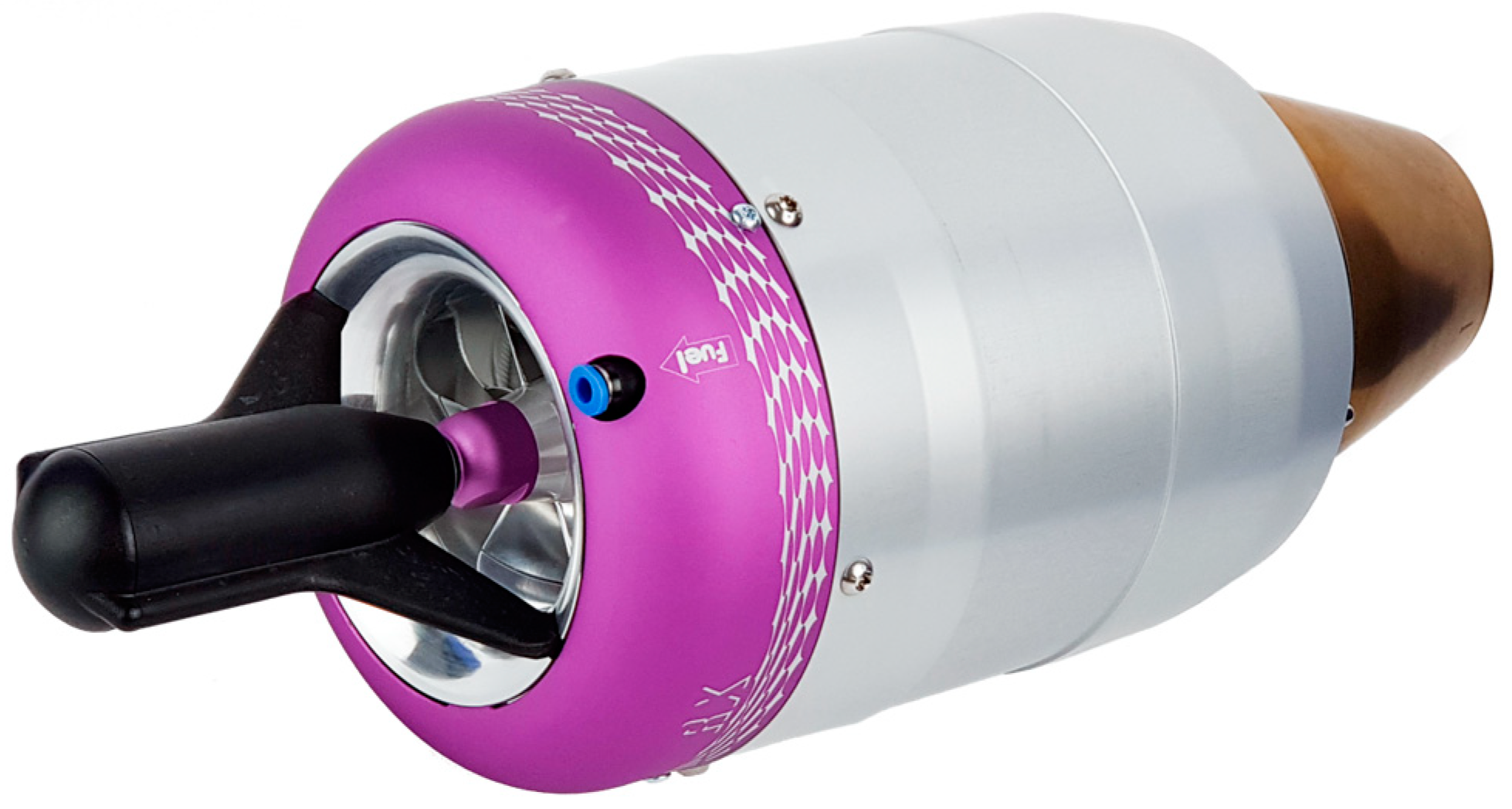
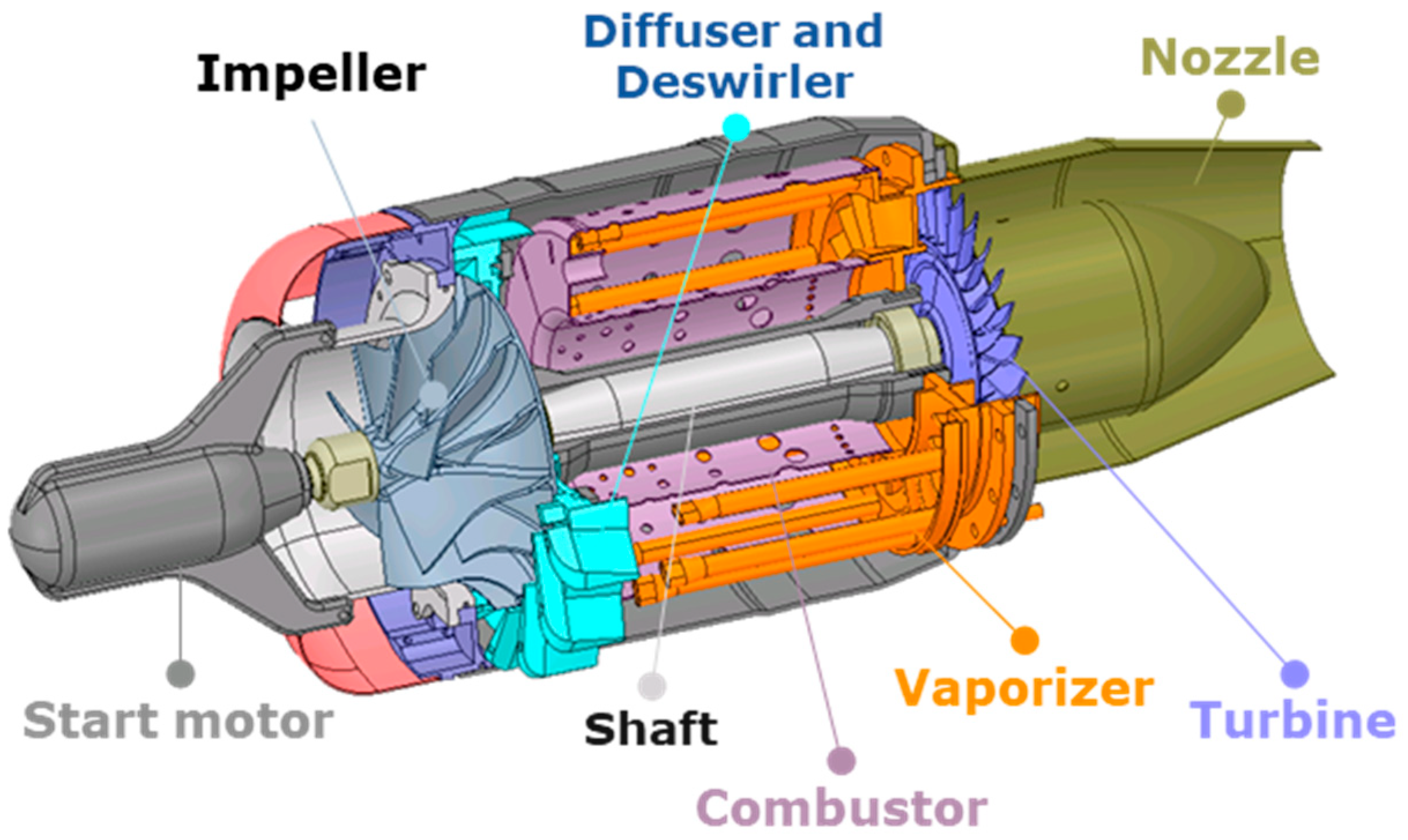

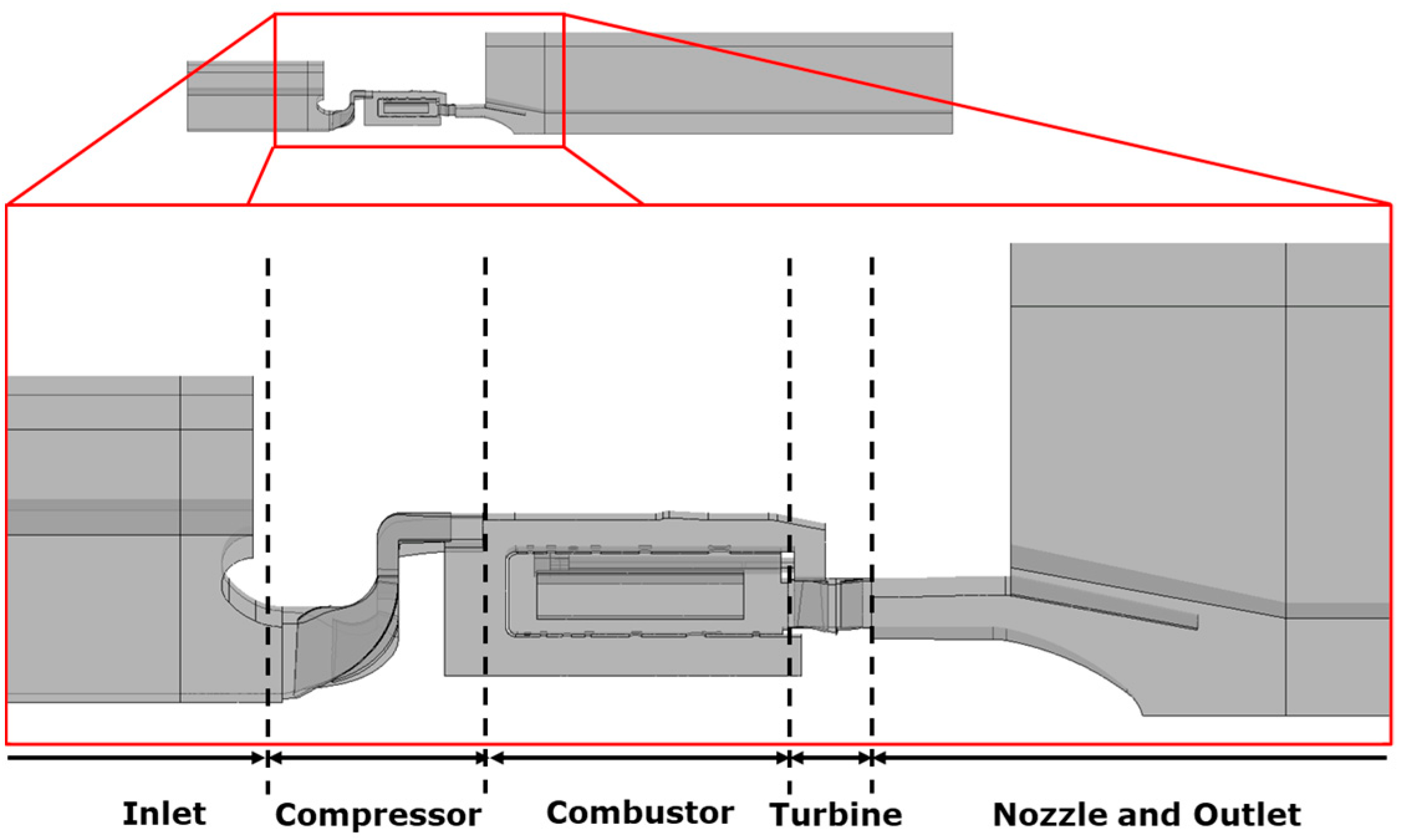
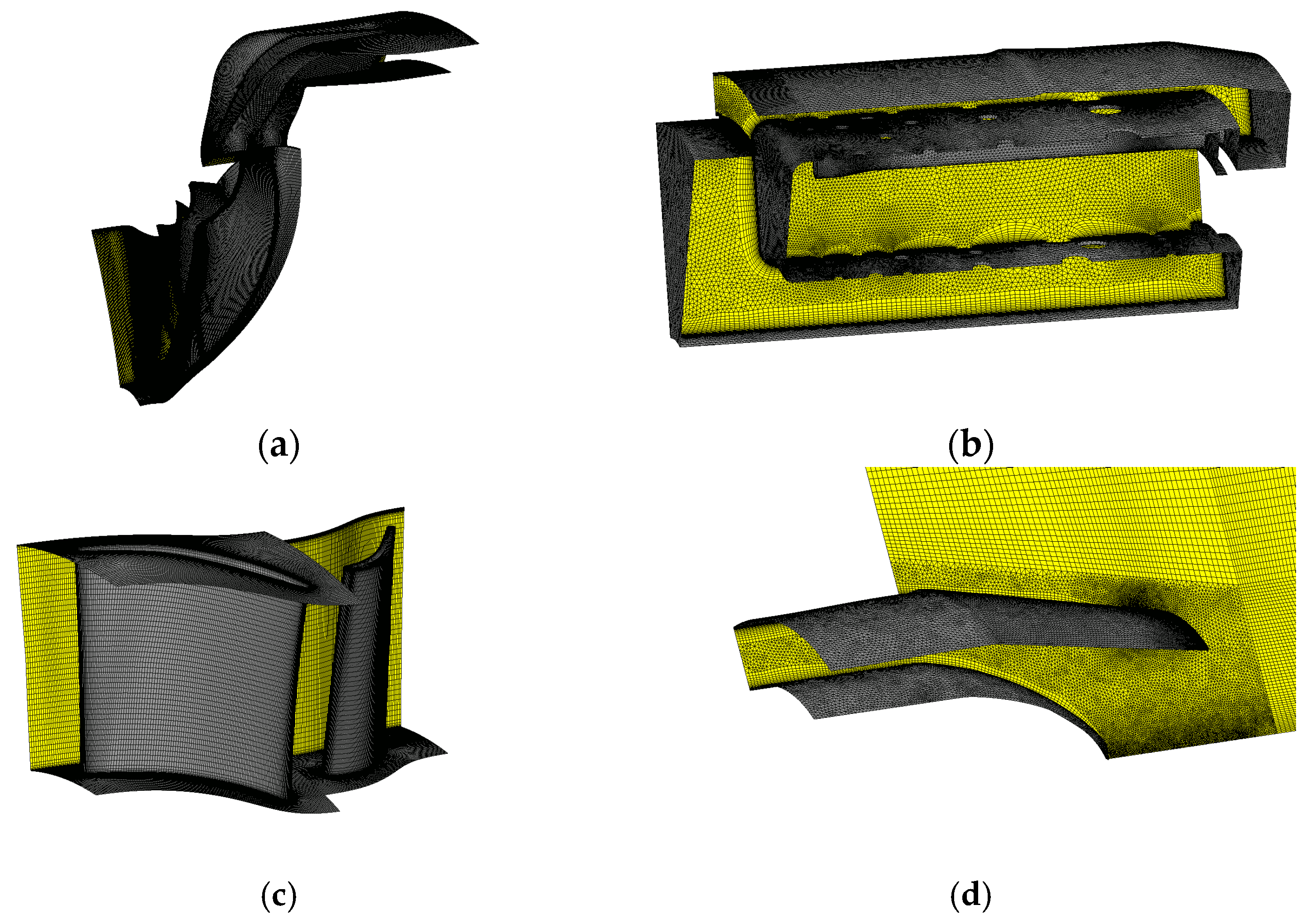

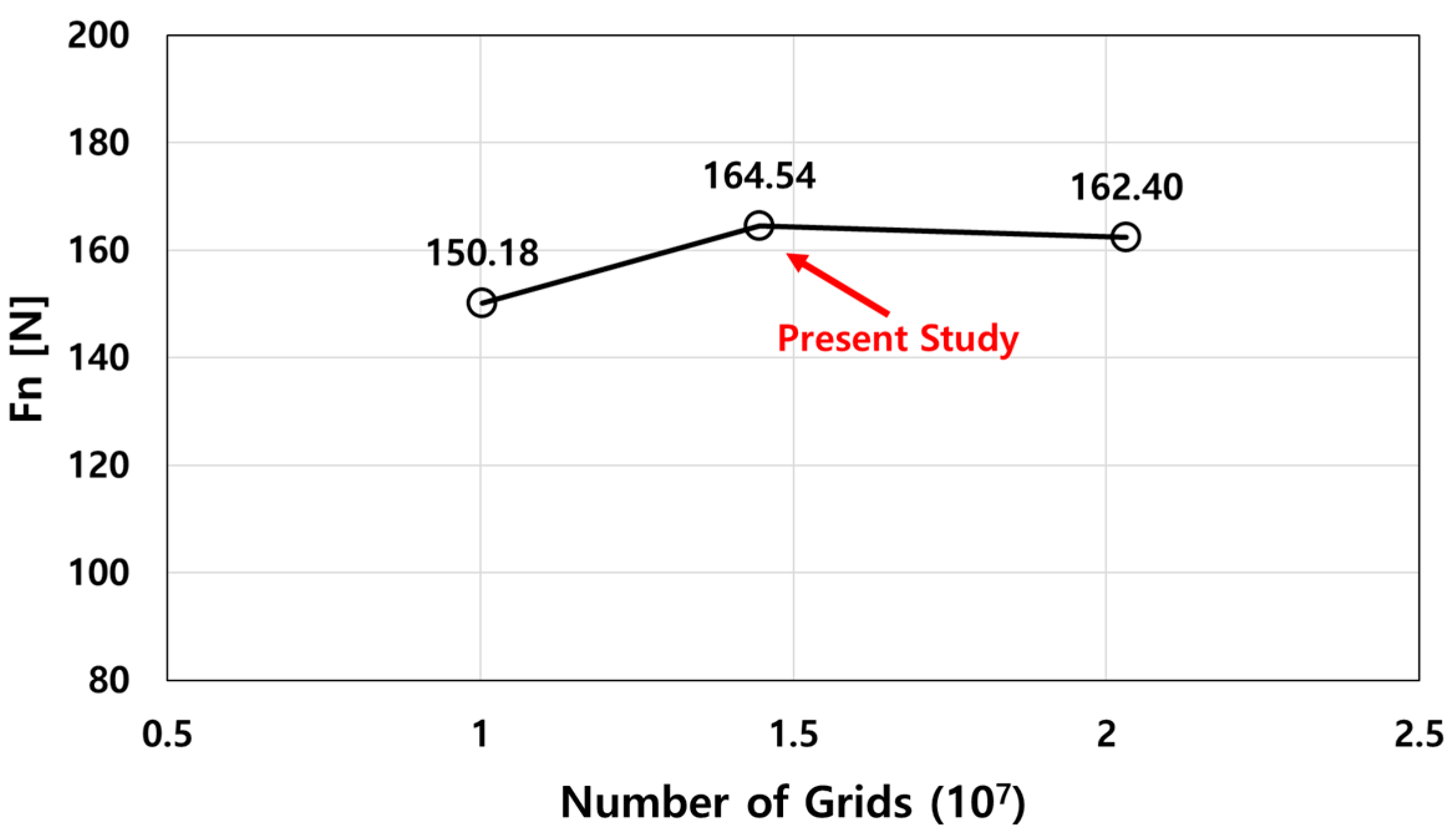

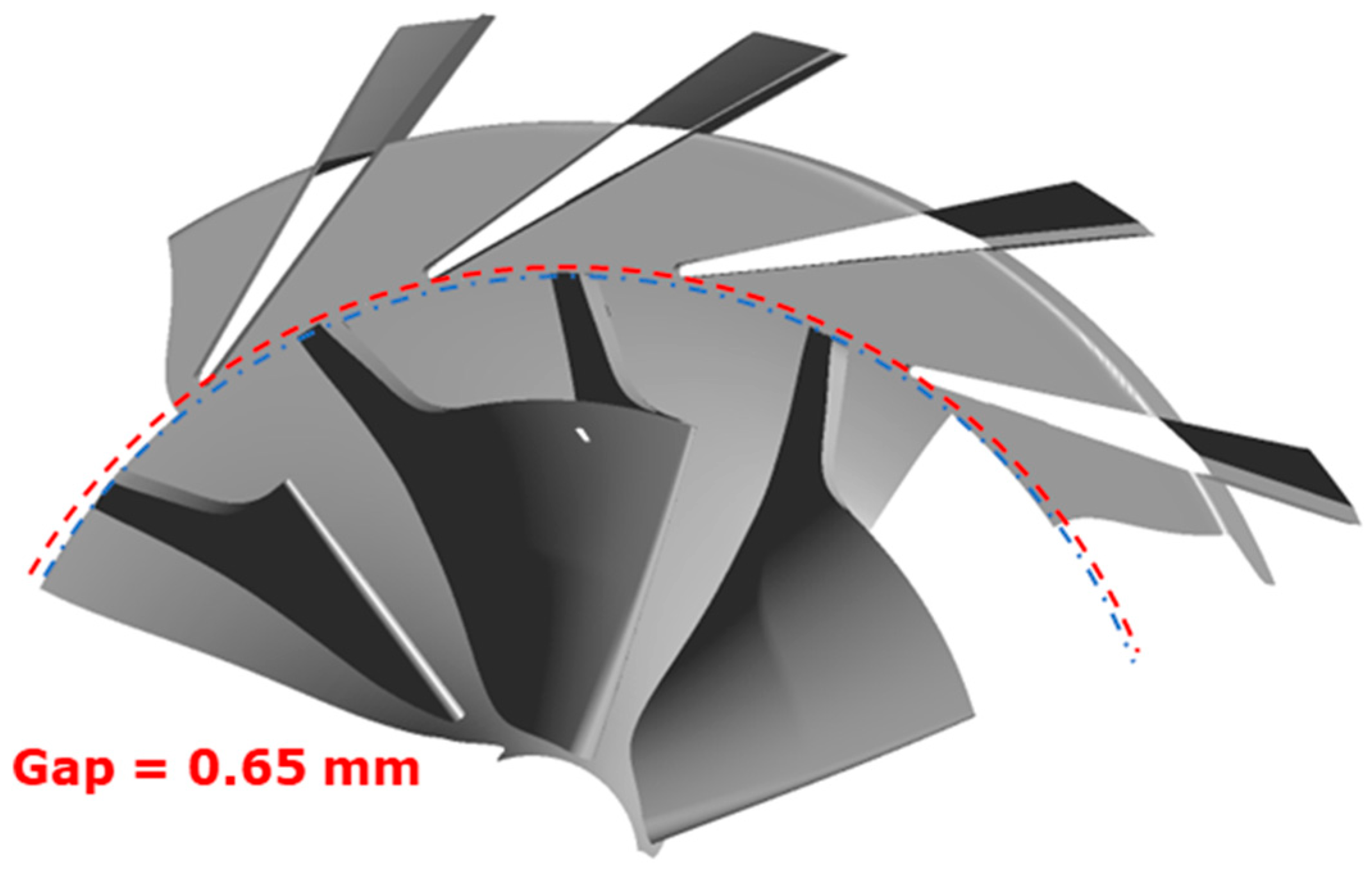
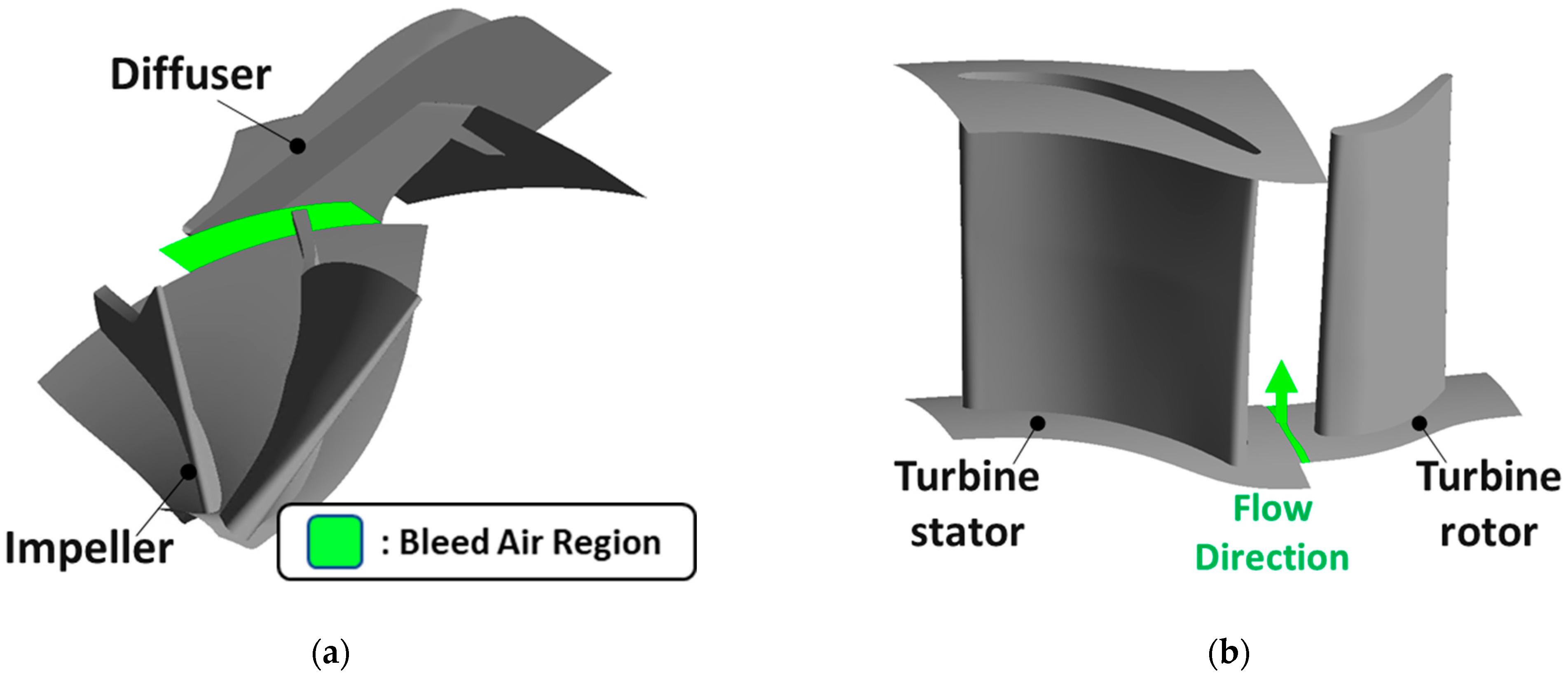
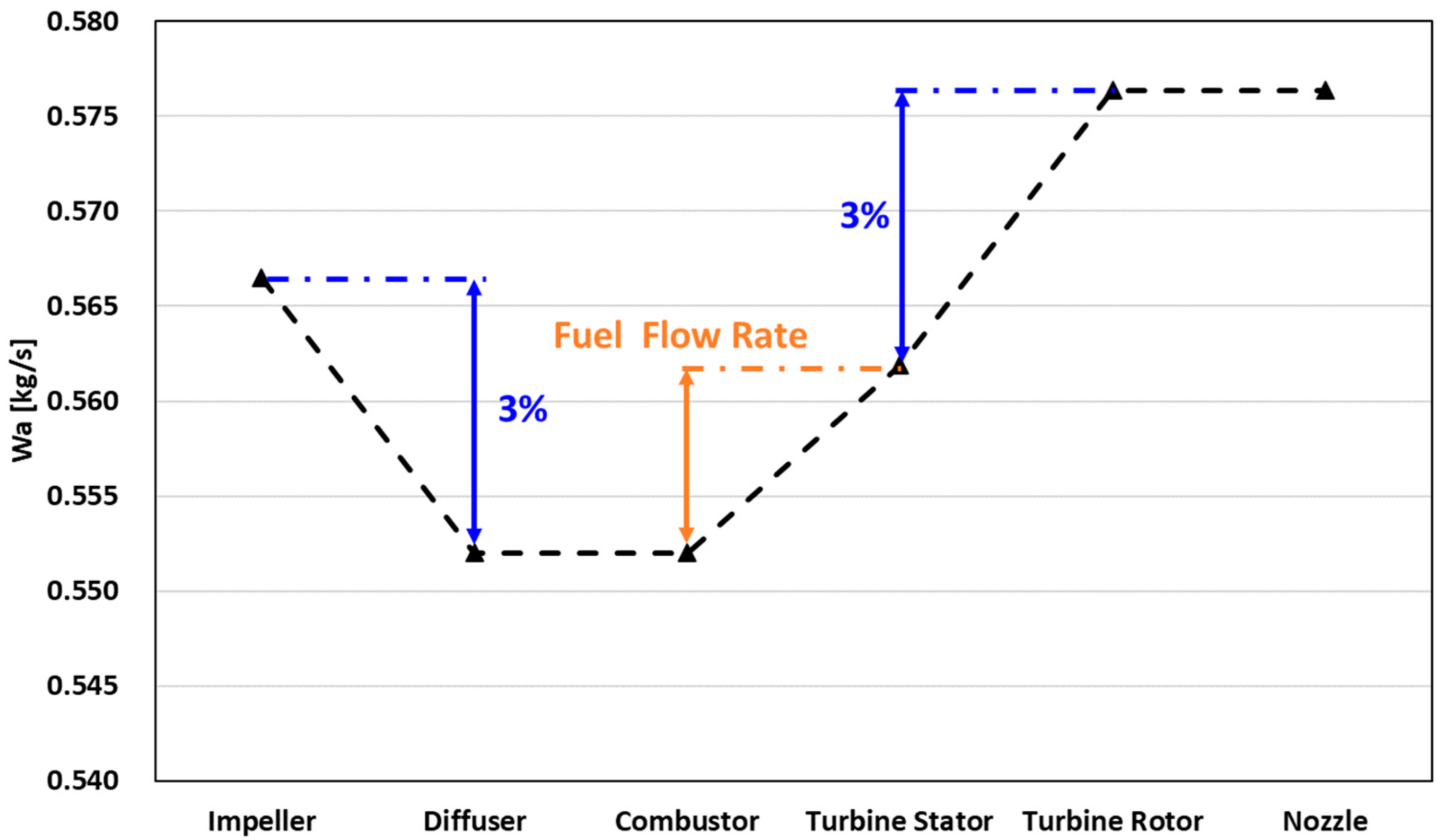



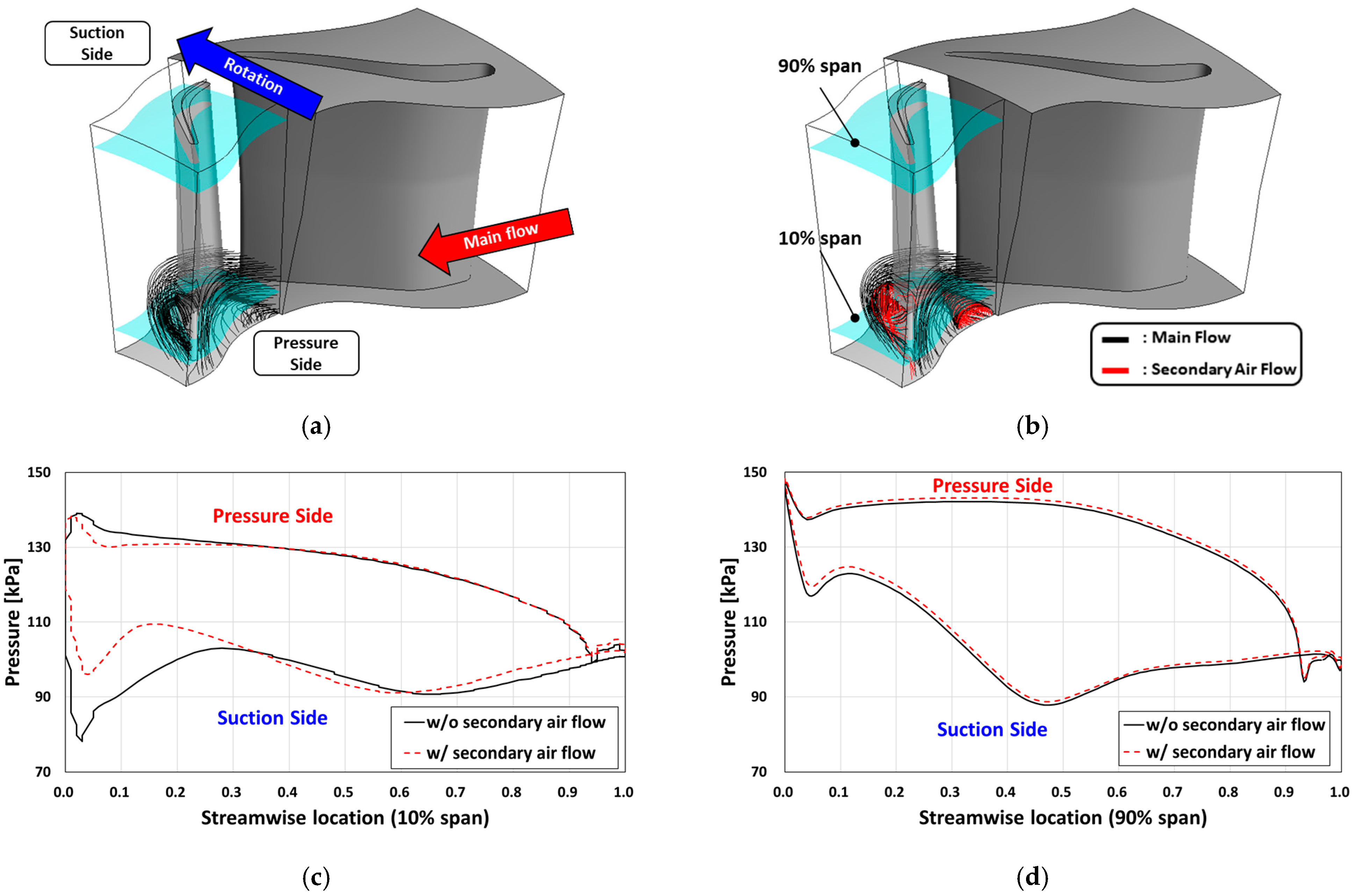
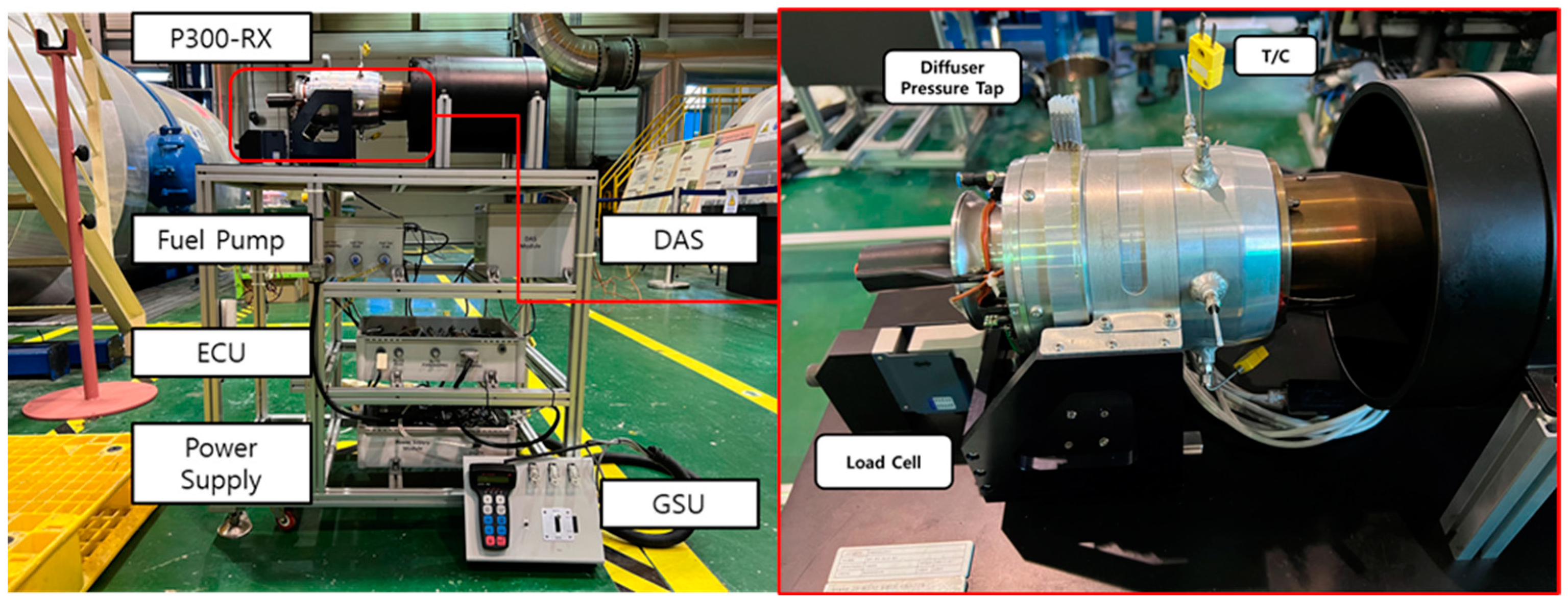








| Parameters | Properties | Unit |
|---|---|---|
| Idle RPM | 35,000 | RPM |
| Max. RPM | 106,000 | RPM |
| Thrust @ Idle RPM | 14 | N |
| Thrust @ Max. RPM | 300 | N |
| Pressure Ratio | 3.55 | - |
| Mass flow rate (Air) | 0.5 | kg/s |
| Fuel Consumption @ Idle RPM | 179 | mL/min |
| Fuel Consumption @ Max. RPM | 980 | mL/min |
| Weight | 2630 | g |
| Diameter | 132 | mm |
| Length (Incl. Start motor) | 365 | mm |
| Component | Sector | # of Elements |
|---|---|---|
| Entry | 360/7° | 821,614 |
| Impeller | 360/7° | 3,007,260 |
| Diffuser | 360/15° | 961,150 |
| Combustor | 360/12° | 3,847,684 |
| Turbine stator | 360/21° | 1,007,880 |
| Turbine rotor | 360/29° | 1,082,720 |
| Nozzle | 360/6° | 3,804,753 |
| Total | - | 14,533,061 |
| No. | Inlet Pressure [kPa] | Inlet Temperature [K] | Simulating Altitude |
|---|---|---|---|
| 1 | 101.325 | 288.15 | 0.0 km (Sea level) |
| 2 | 94.3 | 300.7 | 0.6 km |
| 3 | 84 | 298.9 | 1.5 km |
| 4 | 69.7 | 298.2 | 3.0 km |
| ANSYS, Inc. | ||
| CFD Solver | CFX_2020_R2 | |
| Analysis Type | Steady State | |
| Turbulence Model | SST Model with Reattach Modification | |
| Combustion Model | Eddy Dissipation Model (EDM) | |
| Interface | Impeller-Diffuser | 1. Frozen Rotor w/o Secondary air flow |
| 2. Mixing Plane w/ Secondary air flow | ||
| Rest of all | Mixing Plane | |
Disclaimer/Publisher’s Note: The statements, opinions and data contained in all publications are solely those of the individual author(s) and contributor(s) and not of MDPI and/or the editor(s). MDPI and/or the editor(s) disclaim responsibility for any injury to people or property resulting from any ideas, methods, instructions or products referred to in the content. |
© 2024 by the authors. Licensee MDPI, Basel, Switzerland. This article is an open access article distributed under the terms and conditions of the Creative Commons Attribution (CC BY) license (https://creativecommons.org/licenses/by/4.0/).
Share and Cite
Lee, D.; Chung, H.; Kang, Y.S.; Rhee, D.-H. A Study of an Integrated Analysis Model with Secondary Flow for Assessing the Performance of a Micro Turbojet Engine. Appl. Sci. 2024, 14, 7606. https://doi.org/10.3390/app14177606
Lee D, Chung H, Kang YS, Rhee D-H. A Study of an Integrated Analysis Model with Secondary Flow for Assessing the Performance of a Micro Turbojet Engine. Applied Sciences. 2024; 14(17):7606. https://doi.org/10.3390/app14177606
Chicago/Turabian StyleLee, DongEun, Heeyoon Chung, Young Seok Kang, and Dong-Ho Rhee. 2024. "A Study of an Integrated Analysis Model with Secondary Flow for Assessing the Performance of a Micro Turbojet Engine" Applied Sciences 14, no. 17: 7606. https://doi.org/10.3390/app14177606





